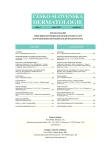Controversions of Dysplastic Nevus
Authors:
B. Rychlý 1; Z. Szép 1,2; M. Švajdler ml. 3
Authors‘ workplace:
CYTOPATHOS, spol. s r. o. – bioptické a cytologické laboratórium, Bratislava
vedúci spoločnosti: Doc. MUDr. Dušan Daniš, CSc.
1; Kožná konzultačná a bioptická ambulancia, Kožné odd. Nemocnice sv. Michala, Bratislava
vedúci oddelenia: prim. MUDr. Ľubomír Zaujec
2; Oddelenie patológie FNsP L. Pasteura, Košice
vedúci oddelenia: prim. MUDr. Marian Švajdler ml.
3
Published in:
Čes-slov Derm, 85, 2010, No. 5, p. 290-293
Category:
Dermatolohistopatology
Overview
Dysplastic naevus is one of the most controversial topics in dermatology. The concept of dysplastic naevi was introduced by Clark in 1978. It was based on the study of families and individuals with multiple melanocytic naevi with predisposition to development of malignant melanoma, characterized by specific clinical and histological features – called dysplastic naevi. Later, the significantly divergent opinions concerning diagnostic criteria, prevalence and significance as diagnostic entity of these lesions appeared. Authors upon their own experience and recently published papers analyse causes of different views on dysplastic naevi and place of dysplastic nevi in modern dermatopathology.
Key words:
dysplastic nevus – classification – clinical criteria – histopathologic criteria – controversion
Sources
1. ACKERMAN, AB., MASSI, D., NIELSEN, TA. et al. Dysplastic nevus: Atypical mole or typical myth? Histopathology, 1999, 35 (5), p.474-475.
2. ARUMI-URIA, M. Dysplastic nevus: the eye of the hurricane. J Cutan Pathol, 2008, 35 (Suppl. 2), p.16–19.
3. BLESSING, K. Benign atypical naevi: diagnostic difficulties and continued controversy. Histopathology, 1999, 34 (3), p.189–198.
4. CLARK, WH., REIMER, RR., GREENE, M. et al. Origin of familial malignant melanomas from heritable melanocytic lesions. ‘The B-K mole syndrome’. Arch Dermatol, 1978, 114 (5), p.732-738.
5. CULPEPPER, KS., GRANTER, RS., MCKEE, PH. My approach to atypical melanocytic lesions. J Clin Pathol, 2004, 57 (11), p.1121–1131.
6. ELDER, DE. Dysplastic naevi: an update. Histopathology, 2010, 56 (1), p.112-20.
7. GERAMI, P., AMANDA WA., MAFEE, M. et al. Fluorescence in situ hybridization for distinguishing nevoid melanomas from mitotically active nevi. Am J Surg Pathol, 2009, 33 (12), p.1783–1788.
8. HUSSEIN, MR. Melanocytic dysplastic naevi occupy the middle ground between benign melanocytic naevi and cutaneous malignant melanomas: emerging clues. J Clin Pathol, 2005, 58 (5), p.453–456.
9. HUSSEIN, MRA., WOOD, GS. Molecular aspects of melanocytic dysplastic nevi. J Mol Diagn, 2002, 4 (2), p.71-80.
10. LEBOIT, PE., BURG, G., WEEDON D. Pathology and genetics of skin tumours. vyd. Lyon: IARC Press, 2006.355 s., World Health Organization, sv. I. ISBN 9283224140.
11. NAEYAERT, JM., BROCHEZ, L. Dysplastic nevi, N Engl J Med, 2003, 349 (23), p.2233-2240.
12. RABKIN, MS. The limited specificity of histological examination in the diagnosis of dysplastic nevi. J Cutan Pathol, 2008, 35 (Suppl.2), p.20-23.
13. SHAPIRO, M., CHREN, MM., LEVY, RM. et al. Variability in nomenclature used for nevi with architectural disorder and cytologic atypia (microscopically dysplastic nevi) by dermatologists and dermatopathologists. J Cutan Pathol, 2004, 31 (8), p.523-530.
Labels
Dermatology & STDs Paediatric dermatology & STDsArticle was published in
Czech-Slovak Dermatology

2010 Issue 5
Most read in this issue
- New Emollients Containing Urea among Extemporaneous Preparations
- Controversions of Dysplastic Nevus
- Frequency of Food Allergy to Egg Proteins in Atopic Patients Older than 14 Years
- Oral and Genital Melanotic Macule
